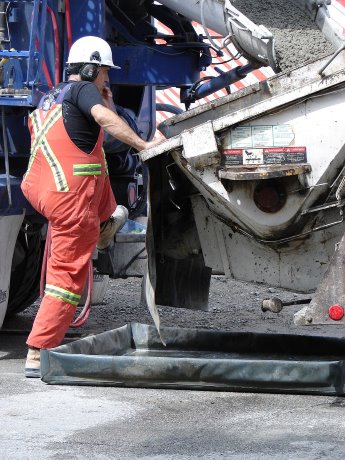The BC Ready-Mixed Concrete Association (BCRMCA) is planning to launch a new competency certification system for operators of concrete pump trucks after completing a pilot program to develop testing procedures on construction sites.
"We have developed all the assessment tools and completed the first pilot program and now we are at the point of going back to the BC Construction Safety Alliance (BCCSA) board with a recommendation to launch a beta phase," said Charles Kelly, president of the BCRMCA. "This will allow us to go out and start to provide competency certification for concrete pump operators in B.C. on a voluntary basis. At the same time, we are continuing to push WorkSafeBC for regulation."
Currently, there is no requirement in B.C. for operators of a concrete pumper truck to receive training or certification. Anyone with a Class III truck driver’s licence can lease any size or configuration of a concrete pump, drive it off the lot and start pumping, without any sort of training or testing of competence
The BCRCMA released a report in June 2016 outlining the results of the pilot program, which consisted of 23 practical assessments of concrete pump operators on five equipment categories:
- low pressure line pump, below 1,231 psi;
- high pressure line pump, above 1,231 psi;
- truck mounted – boom, 41 metres and under;
- truck mounted – boom, over 41 metres; and
- tower placing boom.
The daily workflow of these categories was identified to test the knowledge and performance of each potential candidate. In particular, assessments were designed for the assessor to observe an operator on an actual job site, while setting up to pump concrete, pumping concrete, cleaning up and finally washing out.
This approach is based on the revised American Society of Mechanical Engineers (ASME) safety standard for material placement systems, which was developed in 2014.
"We are very confident and satisfied now that we have a set of assessment tools and can move forward with the certification of people with confidence," said Kelly.
"The test takes six hours to complete because it goes from the arrival of the concrete to the final wash out."
Most of the assessments were conducted in September 2015, but some were undertaken in December 2015.
One of the requirements for participation in the pilot was that an operator had to complete the safety training course and pass the written test provided by the BCCSA and the BCRMCA.
Candidates will be required to complete a recognized Pump Operator Safety Training course and pass a written theory exam before taking the new competency assessment for Pump Operator Certification.
The pilot program has gathered enough information to develop a business model for industry to review and approve, which outlines the cost and terms of delivery for operator assessment in B.C.
The report concludes that the assessment can be delivered economically if the industry co-operates in the scheduling of jobs for the assessor. However, only one assessment can be conducted by each assessor during each day.
The BCRMCA has decided not to proceed with tower placing boom competence certification at this time after the trial assessment revealed the complexity of the use of a placing boom on a work site.
"These tests were completed, but the difficulty is that tower placing booms require a consensus among general contractors, engineers, pump operators and placers about best practices," said Kelly. "Our recommendation here is to take that out until we come up with best practices, due to its complexity."
In this case, more consultation is required to understand the scope of responsibility in terms of delivery system inspection and clean out operation.
The new concrete pump operator standards in B.C. were developed by looking at standards in the United Kingdom, Australia, New Zealand, the United States and Canada.
As a result of this research, it was concluded that the best option was to combine two different sets of standards developed in Canada.
The first standard was developed through industry consultation by the Construction Sector Council in 2005, while the second standard was developed by the Ontario College of Trades in 2014.
The latter standard is used to govern Ontario apprenticeship certification.
Concrete pumping can be one of the most dangerous activities on any construction site, states WorkSafeBC.
For example, WorkSafeBC and the RCMP are investigating an incident that took place on March 11, 2015, where a worker was killed when a concrete pumping truck fell forward at a residential construction site in Chilliwack.

1/2
The BC Ready-Mixed Concrete Association is working on a new competency certification system for operators of concrete pump trucks. The association is now at the point of going back to the BC Construction Safety Alliance board with a recommendation to launch a beta phase.
Photo: Richard Gilbert
2/2
The competency certification for concrete pump operators in B.C. will be on a voluntary basis. The BCRMCA is still continuing to push WorkSafeBC for regulation.
Photo: Richard Gilbert"










Recent Comments
comments for this post are closed